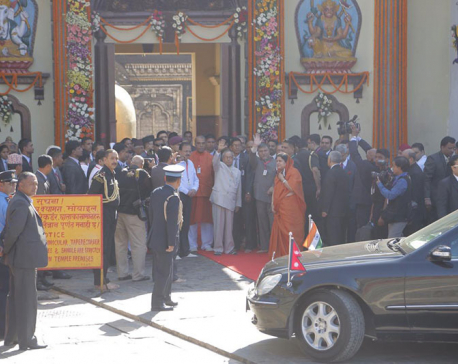
OR
The region’s prosperity depends on the ability of its political leaders to mitigate differences and collectively focus on economic development

Siromani Dhungana
Siromani is associated with Republica daily as coordinator of its Social Bureau. He is responsible for commissioning, coordinating, reporting and writing stories on various issues like migration, human rights, health, education, and other social issues. He has been working as a journalist for 10 years. Twitter: @ siromanidsiromanid@myrepublica.com
Poverty is pervasive and entrenched in South Asian countries. About 399 million people in this region—or 40 percent of the world’s poor—live on less than US $1.25 a day, according to the World Bank. The region is also home to around two-thirds (more than 200 million) of world’s slum-dwellers. This region includes four least developed countries: Afghanistan, Bangladesh, Bhutan and Nepal, a region where half a billion people still live without electricity. Thus there is a need for collective action to lift the bottom 399 million people out of poverty.
Economic growth is the most powerful tool to reduce poverty and improve the quality of lives in poor countries. In the past few decades economic growth achieved through well-known reforms have lifted millions of poor out of poverty in Asia, Africa and Latin America. Further, globalization and liberalization are a reality we must contend with; no single country on its own can achieve sustainable economic growth. Thus regional integration is the key to South Asia’s prosperity.
Why integration?
Generally, economic interests underpin regional integration. Its bottom-line is shared prosperity through accelerated economic activities. Regional collaboration contributes to economic growth and poverty alleviation. In the globalized world, South Asian regional integration is crucial for a number of reasons. First, it helps strengthen the region’s economic gains against vulnerabilities due to global shocks. Second, lack of decent and well-paid jobs remains a major challenge in South Asia. Regional economic integration helps create more decent jobs by promoting manufacturing sector.
Third, it helps individual countries to enhance their capacity in various businesses. Fourth, regional integration can be useful for small and poor countries to move up the value chain and maximize their growth potential. Further, presence of small and poorer countries in regional market via trade integration can help them respond better to business challenges and yield positive spillovers. Last but not least, it can contribute to the region’s long-term peace and stability by ensuring more jobs and sustained growth.
Present context
In South Asia, intra-regional economic integration leaves much to be desired. Historical divisions among SAARC countries have worked against effective regional integration. Despite similarities in history, culture and geography, South Asia is the least integrated region in the world. The World Bank data shows that intra-regional trade accounts for just 5 percent of total trade, compared with 25 percent in the Association of Southeast Asian Nations (ASEAN). Some 95 percent of South Asian trade is focused on Europe, North America and East Asia. By contrast, 25 percent of ASEAN trade is within the region.
Intra-regional trade is five percent of total trade in SAARC region. The comparable figure for ASEAN is 25 percent.
But South Asia also has a vision of economic union. The South Asian Free Trade Area (SAFTA) came into effect in January 2006. One of its major objectives is to promote mutual trade and economic cooperation among member states by “eliminating barriers to trade in, and facilitating the cross-border movement of goods between the territories of the Contracting States”.
Similarly, five countries from South Asia have joined the Bay of Bengal Initiative for Multi-Sectoral Technical and Economic Cooperation (BIMSTEC). The objective of the BIMSTEC is “to harness shared and accelerated growth through mutual cooperation in different areas of common interests by mitigating the onslaught of globalization and by utilizing regional resources and geographical advantages”.
The initiatives so far show that South Asian countries are keen on regional collaboration. At economic forums regional experts often outline the importance of better integration for shared prosperity. Now is the time to make it happen.
Question of will
“ASIA 2050: Realizing the Asian Century” report clearly states that “crucial for increased regional cooperation is strong political leadership. Building Asia’s regionalism will require collective leadership that recognizes a balance of power among participants”.
Hindering South Asian economic integration is lack of political will and sincere effort to materialize One South Asia. Economic issues in SAARC have always been shadowed by the rivalry between India and Pakistan. Recent border blockage might also have widened the mistrust between the political establishments in Nepal and India.

The region’s prosperity depends on the ability of leaders to focus on long-term development by mitigating distrust and differences at the political level. Political leaders from all countries need to work together to work out a South Asian model that builds on positive experience of other regional forum like ASEAN and EU. For long politics divided South Asia. Now is the time to prove that economy can unite it.
Focus on the poor
Divided we lose. If the countries in the region are divided, the process of alleviating poverty will take much longer. As the largest number of the world’s poor resides in the region, political leaders should realize that vicious circle of poverty is our common enemy. And that an integrated, open and inclusive South Asia benefits the poorest the most.
A major difference between South Asia and other regional cooperation regimes is the disproportionate size and influence of one country in South Asia: India. It is not possible for smaller economies in the region to take advantage of regional potential without addressing this basic fact. Smaller countries need access to Indian markets more than the other way around.
India, being a global economy, should take smaller countries into confidence by identifying areas where there can be economic cooperation. Free trade works best when the economies involved complement (rather than compete with) each other. Similarly, smaller countries need to develop competitiveness and they may need some help to identify sectors of comparative advantage.
Businesses in smaller countries in the region would not be able to survive competition from global Indian firms. But they would be able to grow if they are provided access to the large common South Asian market.
Recently, I came across a photo in one of the World Bank Blogs: one showing a young Indian female student at the South Asia Economic Forum 2015. She was holding a placard with the slogan: I believe in #OneSouthAsia. Young generation in the region envision South Asia as a shared space. Now is the time to start a new journey of peace and prosperity by translating the concept of one South Asia into reality. If not now, then when?
The author is associated with Republica daily as coordinator of its Social Bureau. Earlier, he was a researcher-consultant with the World Bank
You May Like This

Fresh hope in South Asia
With new and fresh leadership in South Asian countries, there are hopes that initiatives will be taken to revive SAARC... Read More...

‘Longest waterfall’ in South Asia in state of neglect
TEHRATHUM, Jan 2: The Hyatrung waterfall, arguably the largest one in South Asia, is in the shadows for lack of... Read More...

Kathmandu is a spiritual center for people of South Asia: Mukherjee
KATHMANDU, Nov 4: Indian President Pranab Mukherjee has described Kathmandu as a spiritual center for the people of South Asian region. Read More...

Just In
- Indians vote in the first phase of the world’s largest election as Modi seeks a third term
- Kushal Dixit selected for London Marathon
- Nepal faces Hong Kong today for ACC Emerging Teams Asia Cup
- 286 new industries registered in Nepal in first nine months of current FY, attracting Rs 165 billion investment
- UML's National Convention Representatives Council meeting today
- Gandaki Province CM assigns ministerial portfolios to Hari Bahadur Chuman and Deepak Manange
- 352 climbers obtain permits to ascend Mount Everest this season
- 16 candidates shortlisted for CEO position at Nepal Tourism Board







_20220508065243.jpg)










Leave A Comment